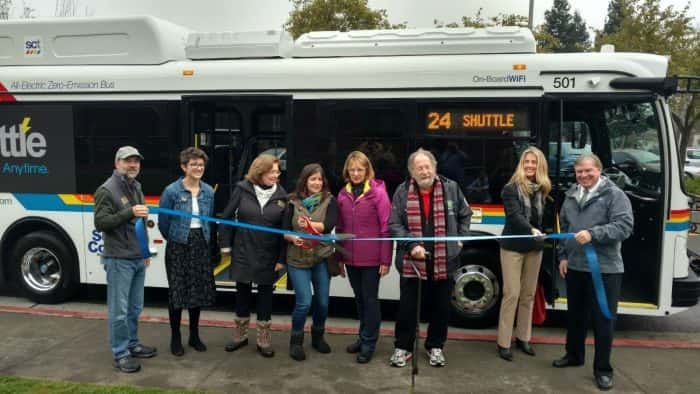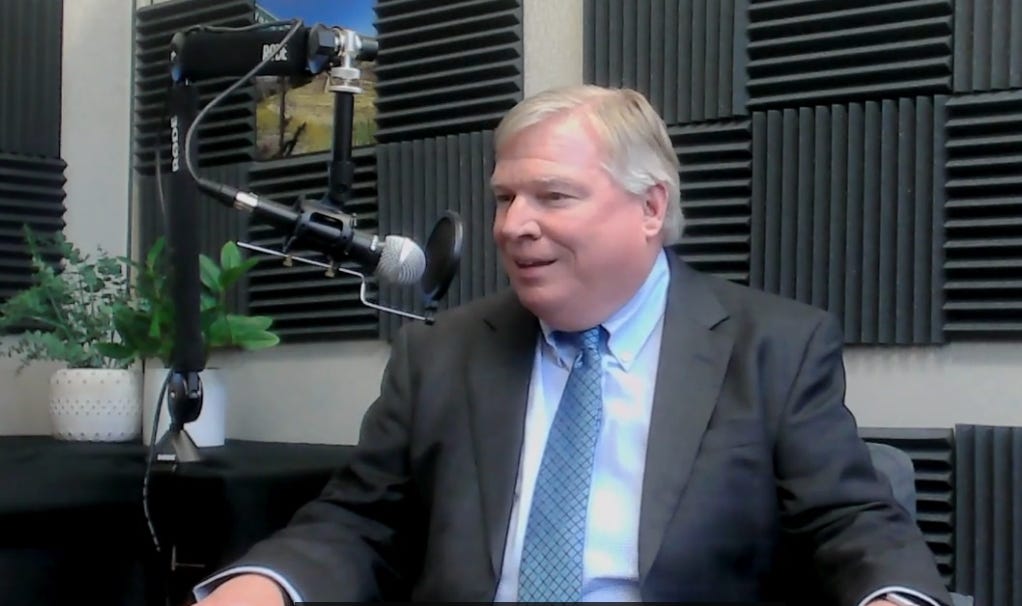Bryan Albee retires from Sonoma County Transit after 40 years on the job
Meet the man who's kept Sonoma County moving forward

Every now and then, the Sebastopol Times takes a look at the bigger picture of what’s happening in Sonoma County. We saw this story in the SoCo Correspondent newsletter about the retirement of Sonoma County Transit’s Transit Systems Manager, Bryan Albee, after 40 years on the job. We learned some things about the transit agency that we didn’t know. Albee has brought a lot of changes to the transit agency over the years, and he’s kept a very low profile. So we thought this would be a good opportunity to shine a light on one of the folks who've kept this county moving all these years.
We are reprinting the article from SoCo Correspondent and an edited transcript of their interview with Albee.
When Sonoma County Transit began in 1980, it consisted of a single bus that ran between Guerneville and Santa Rosa—and only on weekdays. County staff were still using typewriters to conduct business, and young Bryan Albee was a recent graduate of Sonoma State University and the County’s newest intern. The rest, as they say, is history.
Albee, who has overseen the County’s bus system since 1997, will retire this year after more than 40 years of dedicated public service. He helped build an agency that now carries 3,200 people a day.
In the early days, the transit bus fleet consisted of seven used diesel coaches purchased at a bargain from Alameda County. Today, under Albee’s leadership, Sonoma County Transit boasts a fleet of 49 buses that run 19 routes, from Petaluma to Cloverdale, Monte Rio to Sonoma, and everywhere in between.
During his tenure, the transit agency has worked relentlessly to cut pollution, first shifting from diesel to natural gas buses, and now from natural gas to all-electric buses. Half of the entire fleet is expected to be all-electric by 2026, supported by a new electric bus charging facility in Santa Rosa.
Albee also guided Sonoma County Transit through the pandemic, which forced the agency to cut service by 80 percent. Through creative management, Albee has helped return ridership to 85 percent of pre-pandemic levels. He spearheaded numerous efforts to establish fare-free programs for college students, military veterans, youth under age 18 and others. These programs have since been adopted by both Santa Rosa City Bus and Petaluma Transit.
“My interest has always been in transit, so it’s an honor to have served Sonoma County residents as transit manager,” Albee said. “It has been a fulfilling 40 years, and I’m grateful to our drivers, mechanics and administrative staff for their support and perseverance. They’re the real transit heroes.”
An Interview with Bryan Albee
Let’s start with an overview of Sonoma County Transit.
Well, Sonoma County Transit is the County of Sonoma’s transit system. We started in July of 1980, so coming up on 44 years now, and we started with one bus out of Guerneville that came into Santa Rosa on weekdays. So today, we have 49 buses in our fixed-route fleet. We operate seven days a week, and our maintenance facility is open 24/7. So we have changed quite a bit over 44 years. But that has to be.
So today, how many routes are there and what are the busiest?
Well, there's 19 routes that serve the county, and our primary function is inter-city service. So we connect Petaluma to Santa Rosa, Santa Rosa to Cloverdale and then West County (Monte Rio to Santa Rosa), Santa Rosa to Sonoma. Those are the five core routes that we operate, and then we also offer local services for the cities of Rohnert Park and Cotati, Sebastopol, Windsor, Healdsburg, Cloverdale and Sonoma.
You really can get essentially anywhere in Sonoma County on the transit line. We know that during the pandemic ridership here and all over the Bay Area took a real hit. Has ridership bounced back in Sonoma County? What's the status today?
Well, ridership all across the county dropped in March 2020; we just we had less demand. People were sheltering in place, and there was a lot of uncertainty. So we reduced our service to really less than half of its normal amount. We had about 20-30% of our normal ridership for the first few months. But gradually, as things have kind of returned to normal again, today the service operates at about 75 to 80% of our pre-pandemic ridership, and our level of service is about 90%. That compares pretty closely with our counterparts in the Bay Area.
Well, that sounds like we've made pretty decent strides in getting back to where we were.
It has been very slow. We never guessed it would take four years.
We’ve been working to bring awareness to the county's transition from largely natural gas coaches to an all-electric fleet. Where do things stand today in that transition?
Well, we started with one electric bus back in January of 2019, and five years later, we now have nine buses in the fleet of 49. Those are all 30-foot and 35-foot coaches. And those are doing the local services in Sebastopol and Healdsburg and Rohnert Park and Cotati, because they have limited range. And so now we have five 40-foot coaches, the big buses that do inter-city service. They'll be here probably in January of next year. They'll have a longer range, and they’ll be on those routes I mentioned, going from Petaluma to Santa Rosa, Santa Rosa to Cloverdale, and then the East and West routes.
These are all electric, right? They're plug-in, not hybrid. We're actually ahead of the game, aren't we, a little bit in terms of that?
Well, we are. We're about halfway through in terms of the number of buses that we have. We have nine now. We have we'll have 14 at the end of the year. And then we have a pending order for buses to be delivered at about this time in 2026. So in 2026, half of the fleet will be electric. And we set a deadline in our transition plan to achieve that goal by 2040.
Why has the county prioritized this investment in all-electric transportation?
Well, all California public operators have to go in this direction—in the direction of zero-emission vehicles, either electric or hydrogen vehicles. We’ve chosen electric. This is as a result of a California Air Resources Board requirement for the Clean Transportation Program, passed in I think it was in December of 2018 or so, and it requires all transit systems to go toward zero-emission vehicles by I think the deadline is 2040. So it’s not just us. Everyone in the state is quickly transitioning or trying to transition to zero-emission vehicles.
In addition to the ongoing transition to all-electric, I know there's also some fare-free options for riders—for college students, military veterans and youth under age 18. Can you tell us about those programs?
Sure. Well, back in 2015, the county approved fare-free service for all college students. We started it at Sonoma County, but later City Bus and Petaluma Transit have done the same thing. It's been very successful. That was in 2015 with the college students and also, at that time, the county subsidized all trips by veterans. And then since June of last year, all youth can ride all county services free. That includes our system, but also City Bus and Petaluma Transit. So all youth can ride all transit for free. That’s under a two-year pilot program funded by the County Resiliency Program. It’s been very successful. We're hoping that we receive funding to continue it on a permanent basis.
That's great. So for all young people out there, take note: ride transit for free, get to where you need to go safely and without carbon emissions, in many cases. There’s also, I remember, the Clipper Program for low-income adults. Is that still active?
That is still active, and they now receive 50% off their fare if you have a Clipper Card. It’s through the Clipper Start Program.
That's also really important to know. I know that Sonoma County Transit has a very helpful website.
That’s sctransit.com. Our web page has really all the information you need to acquaint yourself with county transit services. We have the maps and the schedules. Need to buy a pass? We sell them online. So it’s kind of the place to start.
If you need to talk with us, you have questions that need a specific answer, like ‘I'm at this location…” Our information staff is there weekdays from 8 am to 5 pm, and they can help you with customizing, even figuring out your transit trip. And if you need to transfer to another system, we can help figure out those trips as well. [That number is 800-345-7433.]
Are there any big changes coming up at Sonoma County Transit?
Well, we added a lot of service back just this last August, and that’s what got us to the 90% level. We think probably this August—usually August was when we introduced major changes at the start of the new school year—we're looking to add just a few more inter-city trips on some of those routes, but also to make some changes to our local Route 10 in Rohnert Park and Cotati, and how we serve Sonoma State University and possibly serve the Green Music Center. We’re working on that now.
So to pivot just a little bit, tell us about your personal journey to Sonoma County Transit. How long have you been with the organization?
Well, I’ve been there for 40 years—it was 40 years back in January. It’s gone by very quickly. But yeah, I went to Sonoma State and started with the County as an intern in another department, Public Works. My interest really was transit, and I got a temporary job with Sonoma County Transit in 1984, which led to other jobs. And then in 1997, I became the transit manager. So it’s been fun. It’s been a great place to work, lots of challenges, and we’ve seen lots of changes.
What keeps you going? What de you like most about your job?
Well, I mean, we always have a lot to do there in different times of the year: we’re working on our budget, working on grants and claims with the Metropolitan Transportation Commission, and right now we're building a new charging facility, which hopefully will be done by August or September, in advance of 40-foot coaches coming in. So I mean, we all have a lot to do. We have a very small staff. There are only three of us on the administrative side. We have accountants, public infrastructure, and then we have an information staff of three people. But the 140 drivers—they really do a lot of the work. So working with them all, it’s been a challenge, but it keeps me going.
Visit www.sctransit.com for maps, schedules, passes and daily service updates. Customer service is available by calling (800) 345-7433.

